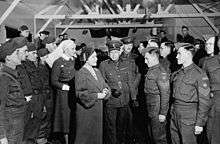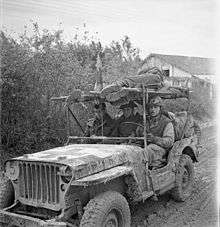Royal Canadian Army Medical Corps
The Royal Canadian Army Medical Corps (RCAMC) was an administrative corps of the Canadian Army.[2]
| The Royal Canadian Army Medical Corps | |
|---|---|
| Active | 1904–1968 |
| Country | Canada |
| Type | Corps |
| Role | (Canadian Army) Permanent Active Militia |
| Motto(s) | Latin: In arduis fidelis ("Faithful through Adversity") |
| Colors | dull cherry |
| March | "The Farmer's Boy"[1] |
_(cropped)).jpg)


The Militia Medical Service was established in 1898.[3] It consisted of an Army Medical Service (officers) and an Army Medical Corps (other ranks). The Hon. Sir F.W. Borden KCMG was appointed Honorary Colonel of the militia's "Canadian Army Medical Corps" on 1 August 1901.
The regimental medical personnel of the Permanent Active Militia were absorbed into the Corps on 2 July 1904. The regular component was titled the "Permanent Active Militia Medical Corps" (P.A.M.C.) and the militia component was titled the "Army Medical Corps" (A.M.C.).[4] As the origin of a permanent medical corps, this date has since been considered the "birth" of the Royal Canadian Army Medical Corps for purposes of seniority among the corps of the Canadian Army, coming after the Royal Army Service Corps, 1903. (Though in the militia the medical corps was the first of the support branches to be formed).
Separate titles for permanent and non-permanent components of the medical corps were discarded during the re-organization of 1 May 1909. Thereafter, both permanent (regular) and non-permanent (reserve) components using the title "Canadian Army Medical Corps" (C.A.M.C.). The regular component of the service was redesignated "The Royal Canadian Army Medical Corps" on 3 November 1919; the militia component was granted the same honour on 29 April 1936, becoming the "Royal Canadian Army Medical Corps". These two elements were re-organized for administrative purposes following the Second World War, on 22 March 1948, as "The Royal Canadian Army Medical Corps".[5] The corps suffix "RCAMC" was added to the designation of all corps units from 1944.
The badge of the Royal Canadian Army Medical Corps consists of the rod of Asclepius (a serpent entwined around a staff) surrounded by a wreath of maple leaves, surmounted by the Royal Crown, with the name "Royal Canadian Army Medical Corps" on a scroll below. The earlier badge of the Canadian Army Medical Corps (1909) was identical, minus the prefix "Royal" on the scroll. The previous badge of the Army Medical Service and Army Medical Corps consisted of a Geneva Cross on a silver maple leaf (1899). The badge of the Royal Army Medical Corps was briefly used by some members during the embryonic period of the service (1898).
After the Second World War, a series of coloured berets were adopted, with other arms and services wearing midnight blue berets, with a large coloured "flash" in corps colours – dull cherry for the Royal Canadian Army Medical Corps.[6]
Her Majesty Queen Elizabeth, the Queen Mother, was appointed Colonel-in-Chief of the R.C.A.M.C. in 1954, at the time of the 50th Anniversary celebrations of the Corps.
Integration and unification
In 1959 the Royal Canadian Army Medical Corps joined with the medical services of the Royal Canadian Navy and Royal Canadian Air Force to form the Canadian Forces Medical Service. Medical personnel continued to wear the uniform of their respective service, but were functionally integrated under the professional direction of the newly-created Surgeon General of the Canadian Forces. Medical administration, personnel development and individual training were standardized within the CFMS in order to facilitate the operation of tri-service hospitals and joint medical headquarters. Fighting units continued to obtain integral medical support from their own uniformed personnel. Hospitals, medical headquarters, training schools and equipment depots and research facilities were staffed by CFMS members of all three services, resulting in a larger, more capable and more flexible organization (and more economical).
When the Royal Canadian Navy, Canadian Army and Royal Canadian Air Force were merged in 1968 to form the Canadian Forces, the Royal Canadian Army Medical Corps was deactivated in the Regular Force, and its personnel absorbed by the re-organized Canadian Forces Medical Service, which became a personnel branch of the new Canadian Forces. Reserve units of the Royal Canadian Army Medical Corps continued to exits, using their R.C.A.M.C. titles, until re-organization of the Reserve Force in 1974, when the corps' final disbandment was effected.
See also
References
- Canadian Forces publication A-AD-200-000/AG-000, "The Honours, Flags and Heritage Structure of the Canadian Forces"
- The Regiments and Corps of The Canadian Army (Queen's Printer, 1964)
- http://digital.library.upenn.edu/women/adami/camc/camc.html J. George Adami War Story of the Canadian Army Medical Corps London: Colour Ltd.; The Rolls House Publishing Co., 1918
- http://www.cmhg.gc.ca/cmh/page-587-eng.asp Canadian Military Life After South Africa
- The Regiments and Corps of The Canadian Army (Queen's Printer, 1964)
- canadiansoldiers.com
Further reading
- "The Army Medical organization". Juno Beach Centre.
- Gerald W. L. Nicholson (1977). Seventy Years of Service: A History of The Royal Canadian Army Medical Corps. Borealis Press. ISBN 0-919594-61-1.
- Gerald W. L. Nicholson (1975). Canada's Nursing Sisters. Toronto: Canadian War Museum.
- Andrew Macphail (1925). Official History of the Canadian Forces in the Great War 1914-19 : The Medical Services. Ottawa: F.A. Acland, King's Printer.
External links
| Wikimedia Commons has media related to Royal Canadian Army Medical Corps. |
- War Story of the Canadian Army Medical Corps by J. George Adami. London: Colour Ltd.; The Rolls House Publishing Co., 1918, online edition at A Celebration of Women Writers
- Canadian Forces Medical Service—Introduction to its History and Heritage
- Critical Care On the Battlefield and Around the World: The Story of the Canadian Forces Health Services—Canadian War Museum
- Canadian Forces Health Services Heritage Trust